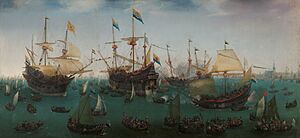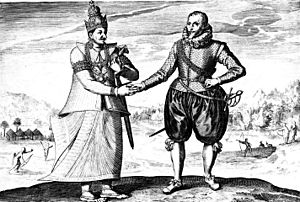Compagnie van De Moucheron facts for kids
The Compagnie van De Moucheron was an early Dutch trading company. It was a step before the much bigger Verenigde Oost Indische Compagnie (VOC), also known as the "Dutch East India Company." This company was started by Balthazar de Moucheron, a ship owner from Antwerp. When Antwerp faced difficulties, he moved his business to Zeeland in the Dutch Republic. The Compagnie van De Moucheron had three ships: 'Ram', 'Schaap' (Sheep), and 'Lam' (Lamb). The fleet was led by Joris van Spilbergen. They set sail on May 5, 1601, and returned to the Netherlands in 1604.
Contents
What Was the Compagnie van De Moucheron?
This trading company was founded by Balthazar De Moucheron. Many of his earlier business partners had left his previous company to join another group called the United company of Zeeland. De Moucheron decided to start his own new venture.
Early Dutch Trading Companies
Before the famous Dutch East India Company (VOC) was formed, there were many smaller Dutch companies that traded with Asia. These were called "voorcompagnieën" (pre-companies). They operated between 1594 and 1602. Rich merchants from the Northern Netherlands and immigrants from the Southern Netherlands helped pay for these companies.
There was a lot of competition between these small companies. They were all trying to get the best goods and trade routes. Because of this fierce competition, the government decided to step in. They made these smaller trading companies join together. This is how the powerful Dutch East India Company (VOC) was created. The VOC then received special rights to be the only company allowed to trade with Asia for the next 21 years.
The Moucheron Company's Journey
In 1601, Balthazar De Moucheron sent Joris van Spilbergen on an important expedition. Van Spilbergen led the three ships, Ram, Schaap, and Lam. Their goal was to create new trade connections, especially with the Kingdom of Kandy in what is now Sri Lanka. They also planned to reach Atjeh.
Meeting the King of Kandy
Joris van Spilbergen successfully met with the king of Kandy, Vimala Dharma Suriya, in 1602. They talked about the possibility of trading valuable cinnamon. When van Spilbergen returned to Zeeland in 1604, he brought back amazing treasures. He had received gifts from the king, including rubies, sapphires, topazes, and many other beautiful gemstones. However, by the time he arrived, the independent companies in Holland and Zeeland had already combined to form the much larger Dutch East India Company.



